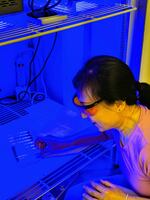
Yujuan Song handles fruit flies used in the study about blue light exposure.
Jaga Giebultowicz
The effects of exposure to blue light through our eyes aren’t new. But, are there more ways exposure to blue light impacts us? Oregon State University scientists used fruit flies to investigate.
Fruit flies have a similar cell structure to humans and one fruit fly day is like one human year. This means scientists can see the effects they’re studying pretty quickly.
After a lifetime of blue light exposure, the fruit flies showed neurodegeneration. Unlike fruit flies, humans have skulls to protect their brains from blue light.
OSU Professor Emeritus Jaga Giebultowicz said this means people may not have the same neurodegeneration. Also, a person’s lifespan isn’t likely to be shortened by blue light exposure, but the findings still have implications for humans.
“Even relatively dim blue light over time with chronic exposure may have detrimental effects,” she said. “Making cells to age faster, possibly damaging them so they become cancerous. Just overall, you know, being detrimental to health.”
Blue light can be found in such things as electronics and ambient light. And with the increasing use of LEDs, our exposure to blue light also increases.
Giebultowicz says one way to protect yourself is to use ‘night mode’ on your computer and phones.
Copyright @2022, KLCC.